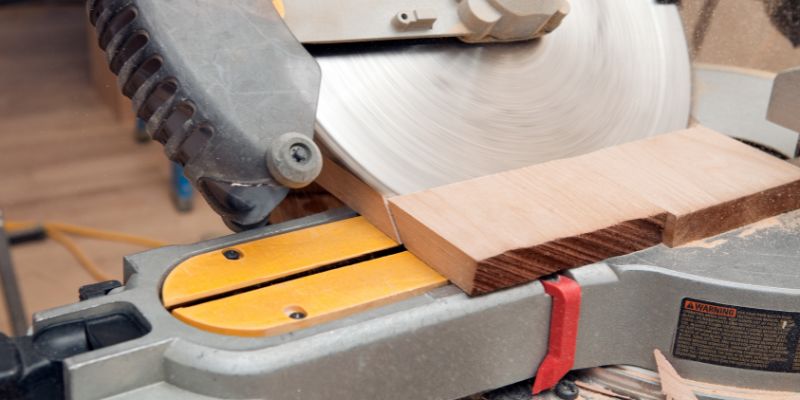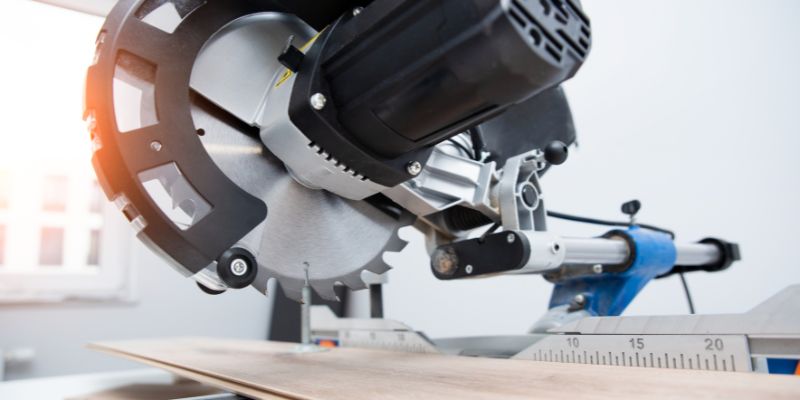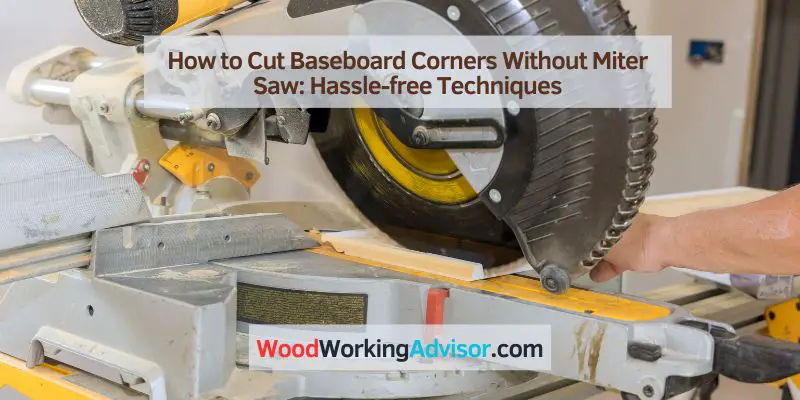To cut baseboard corners without a miter saw, use a coping saw or a miter box with a hand saw. These tools allow you to achieve clean, precise cuts for a professional finish.
When cutting inside corners, use a coping saw to remove the excess material from the back of one piece, allowing it to fit snugly against the other. For outside corners, a miter box and hand saw can create the necessary angled cuts.
With the right technique and tools, you can achieve seamless baseboard corners without a miter saw, enhancing the overall aesthetics of your interior space.
Cutting Baseboard Corners Without Miter Saw
Learn how to cut baseboard corners without a miter saw using a coping saw or a simple miter box. Measure, mark, and carefully cut the baseboards to create seamless corners for a professional finish. Mastering this technique can save time and effort for your DIY projects.
Introduction To Hassle-free Techniques
When it comes to trimming baseboard corners without a miter saw, there are several hassle-free techniques you can use to achieve clean and precise cuts. While a miter saw is typically the go-to tool for cutting baseboard corners, not everyone has access to one. Fear not, as there are alternative methods that can be just as effective for achieving professional-looking results.
Understanding Typical Corner Types
Before delving into the methods for cutting baseboard corners without a miter saw, it’s essential to understand the typical corner types you may encounter. Inside corners and outside corners are the two primary types, each requiring a different approach when it comes to cutting and fitting baseboards. By gaining a clear understanding of these corner types, you’ll be better equipped to choose the right technique for your specific needs.
Safety And Preparation Tips
When undertaking any DIY project, safety should always be a top priority. Before embarking on cutting baseboard corners without a miter saw, it’s crucial to take the necessary precautions to ensure a safe working environment. This includes wearing appropriate safety gear, such as goggles and gloves, and taking the time to prepare your workspace for the task at hand. By following these safety and preparation tips, you can proceed with confidence and peace of mind.

Preparing Baseboard Corners
When it comes to installing baseboards, getting those perfect corners can be a bit tricky, especially if you don’t have a miter saw handy. However, with the right tools and techniques, you can achieve clean and professional-looking corners without a miter saw. In this guide, we’ll focus on preparing baseboard corners and the essential tools needed for manual cuts.
Marking The Baseboards Accurately
Before making any cuts, it’s crucial to measure and mark the baseboards accurately for precise corner cuts. Use a measuring tape to determine the length needed for each wall and mark the measurements with a pencil. Ensure that the measurements are taken from the backside of the baseboard to avoid any gaps when installed.
Essential Tools For Manual Cuts
When cutting baseboard corners without a miter saw, you’ll need a few essential tools to ensure clean and accurate cuts. These tools include:
- Backsaw or Coping Saw: For cutting the baseboard at a precise angle without a miter saw.
- Miter Box: Provides a guide for making angled cuts on the baseboards.
- Wood Clamps: Helps to secure the baseboard in place during the cutting process.
- Pencil and Ruler: For marking and measuring the baseboards accurately.
- Sanding Block: To smoothen any rough edges after cutting the baseboards.
Hassle-free Hand-cutting Techniques
When it comes to cutting baseboard corners without a miter saw, opting for hassle-free hand-cutting techniques can be a game-changer. Not everyone has access to a miter saw, so learning how to achieve precise cuts using manual tools is essential. In this guide, we will explore some effective hand-cutting methods that can make the process easier and more accurate. Let’s dive into the world of hassle-free hand-cutting techniques for baseboard corners.
Utilizing Hand Saws Effectively
Hand saws are versatile tools that can create clean and accurate cuts for baseboard corners. Here are a few tips to make the most of hand saws:
- Choose a fine-toothed hand saw for smoother cuts.
- Secure the baseboard firmly in place to prevent shifting during cutting.
- Use a marking gauge to ensure precise measurements.
- Practice patience and steady strokes to achieve clean, straight cuts.
Coping Saw Method For Precise Joints
When it comes to achieving precise joints for baseboard corners without a miter saw, the coping saw method is a go-to technique. Here’s how to use a coping saw effectively:
- Start by making a 45-degree miter cut at the end of the first baseboard.
- Use the coping saw to carefully remove the waste material from the mitered end, following the profile of the baseboard.
- Ensure a snug fit by consistently checking the cope against the adjoining baseboard.
Angles Made Easy
Cutting baseboard corners without a miter saw may seem challenging, especially when precision is key. However, with the right tools and a few simple techniques, achieving perfect corner angles can be easier than you think. In this post, we’ll explore how to cut perfect corner angles without a miter saw, using a protractor or angle finder.
How To Cut Perfect Corner Angles
When it comes to cutting baseboard corners without a miter saw, precise measurements and angles are essential for a professional finish. To achieve perfect corner angles, follow these steps:
- Measure and mark the length of each baseboard piece to fit the corner.
- Use a protractor or angle finder to determine the angle of the corner. Ensure each angle is accurately measured to avoid gaps or overlapping joints.
- Transfer the angle measurements to the baseboard and carefully cut along the marked lines using a handsaw or a coping saw.
- Test fit the pieces to ensure a tight and seamless corner joint.
Using A Protractor Or Angle Finder
An important tool for achieving precise corner angles when cutting baseboard without a miter saw is the protractor or angle finder. These tools allow you to measure and replicate the exact angles of the corner, ensuring a perfect fit for the baseboard pieces. Here’s how to use a protractor or angle finder effectively:
- Place the protractor or angle finder against the corner to determine the angle measurement.
- Carefully align the tool with the corner and read the angle indicated on the scale.
- Transfer the measured angle accurately to the baseboard for cutting.
- Double-check the measurements to ensure precise cuts and seamless corner joints.
Establishing Seamless Joints
Creating seamless joints is crucial when cutting baseboard corners without a miter saw. Without the right technique, the joints can be disjointed and unsightly. By following the steps below, you can establish perfect joints for a professional finish.
Fine-tuning The Edges With Sandpaper
After cutting the baseboard corners without a miter saw, use fine-grit sandpaper to smoothen any rough edges. Sanding the edges helps to ensure a perfect fit and seamless joints when the pieces are joined together.
Aligning And Securing Baseboard Pieces
Once the edges are fine-tuned, proceed by aligning the baseboard pieces at the corners. Employ clamps to secure them tightly in place before fastening them together. This meticulous approach is vital in achieving a flawless and seamless joint

Finishing Touches Without Power Tools
Finishing touches can make all the difference in achieving a professional look, even without power tools. When it comes to cutting baseboard corners without a miter saw, there are still a variety of ways to ensure that your project has a clean and polished appearance. From caulk and paint applications to creative solutions for complex corners, these finishing touches are essential for a seamless finish.
Caulking And Paint For A Professional Look
Caulking and paint are crucial elements for achieving a professional and polished finish when cutting baseboard corners without a miter saw. Once the baseboards are in place, use high-quality latex caulk to fill any gaps at the corners and along the top and bottom edges. After applying the caulk, smooth it out with a damp cloth for a seamless finish. Then, apply a coat of primer followed by paint to match the baseboards, ensuring that the corners are neat and precise.
Creative Solutions For Complex Corners
In cases of complex corners where traditional miter saw cuts are not feasible, creative solutions can provide a seamless finish. For inside corners, a coping saw can be used to create precise cuts that match the profile of the baseboards, ensuring a snug fit. Similarly, outside corners can be addressed using a combination of miter and straight cuts, paired with careful sanding and fitting to achieve a professional result without a miter saw.
Frequently Asked Questions Of How To Cut Baseboard Corners Without Miter Saw
Can Baseboard Corners Be Cut Without A Miter Saw?
Yes, you can use alternative tools like a coping saw or a pull saw to achieve clean and precise baseboard corner cuts without a miter saw. These tools provide a workaround for those who don’t have access to a miter saw.
What Are The Alternatives To A Miter Saw For Cutting Baseboard Corners?
Apart from a miter saw, you can utilize tools like coping saw, pull saw, or a miter box and hand saw to achieve accurate baseboard corner cuts. These alternatives provide flexibility for DIY enthusiasts and those without specialized equipment.
Are There Special Techniques For Cutting Baseboard Corners Without A Miter Saw?
Yes, coping is a widely used technique for cutting baseboard corners without a miter saw. It involves creating a precise, complementary shape to fit the profile of the baseboard, resulting in seamless corner joints for a professional finish.
Conclusion
Cutting baseboard corners without a miter saw is achievable with the right techniques and tools. By using a coping saw, miter box, or angle finder, you can achieve precise and clean cuts. It’s important to measure accurately and take your time to ensure professional-looking results.
With these methods, you can achieve seamless baseboard corners without the need for a miter saw. Mastering these techniques will empower you to tackle baseboard projects with confidence and precision.


